On the 6th November the barbican arts centre (the only appropriate setting for such an event) will be holding a panel discussion on Brutalism in its event Brutalism: The Savage and The Sublime. The discussion will be based on the recent film by Jonathan Meades Bunkers Brutalism And Bloodly mindedness in which he explored in his usual idiosyncratic manner the controversies of the brutalist style which fascinates him.
The panel is made of Sir Simon Jenkins, chairmen of the National trust, journalist and author, as well as the architectural critic Douglas Murphy (see his articles), the architect Piers Gough and of course Jonathan Meades himself will be debating brutalism and 'the aesthetics and morality of concrete'.
This promises to be a very interesting discussion and not an event to miss! tickets will be sold out quickly so book now!
More information can be found on the barbican website here
Tickets are £10
The panel is made of Sir Simon Jenkins, chairmen of the National trust, journalist and author, as well as the architectural critic Douglas Murphy (see his articles), the architect Piers Gough and of course Jonathan Meades himself will be debating brutalism and 'the aesthetics and morality of concrete'.
This promises to be a very interesting discussion and not an event to miss! tickets will be sold out quickly so book now!
More information can be found on the barbican website here
Tickets are £10









































